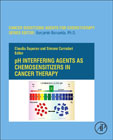
pH Interfering Agents as Chemosensitizers in Cancer Therapy
Supuran, Claudiu T.
Carradori, Simone
PH Interfering Agents as Chemosensitizers In Cancer Therapy provides a detailed overview of the chemosensitizers for the treatment of cancer spanning from biochemical and structural features to pharmacology and drug-design, including technological applications of such tools. It is structured with innovative book setting outlines and a clear distinction between experimental and clinical results, in order to aid the reader to gradually enter in the different issues of such a wide and intricate topic. The continuous discovery and assessment of the role played by old/new synthetic drugs, natural compounds, and technological applications thereof led to the urgent need of classification in terms of biological activity, mechanism of action, clinical outcomes, cancer cell lines sensible to the treatment, and potentialities to better orient the research in this field. Moreover, all the aspects relevant for medicinal chemistry (drug design, structure-activity relationships, permeability data, cytotoxicity, appropriate statistical procedures, and molecular modelling studies) is strictly considered. It is more than ever necessary to properly gather all issues over chemosensitizers to guide researchers to more concrete applications for cancer treatment. Presents a broad view of the topic according to a medicinal chemistry-based approach beyond syntheses and biological assays, focusing on SAR studies, chemoinformatic, drug targeting and molecular modellingExplains graphically the mechanism of action of the chemosensitizers by means of schemes and figures to facilitate the comprehensionDiscusses novel targets to study to explore new possibilities to enhance the research qualitative level in the field INDICE: PART I General overview of the topic: An update 1. General introduction about general mechanisms of resistance in cancer (hypoxia, efflux pumps, tumoral microenvironment) and use of chemosensitizers in association with drugs already in the market 2. Clinical studies analysis 3. Combination therapy 4. Oncoimmunology PART II Chemosensitizing agents with a validated mechanism of action 5. pH regulators of the tumoral microenvironment 6. Proton Pump Inhibitors (PPIs) and other pH buffering agents 7. Selective hCA IX and XII inhibitors 8. Epigenetic modulators 9. Photosensitizing agents 10. Efflux pumps and ABC transporter subfamily inhibitors (e.g., cyclosporin A, verapamil) 11. Metalloproteinase inhibitors (e.g., ADAM17) 12. Kinesin inhibitors 13. Drug repurposing 14. Innovative and putative targets for chemosensitizers 15. Patent survey on chemosensitizers PART III Chemosensitizing agents from natural sources 16. Natural compounds as chemosensitizers: a lesson from plants 17. Natural compounds: from food to clinic PART IV Chemosensitizing agents: computational tools and technological approaches 18. Virtual screening and chemoinformatics of new library of chemosensitizers 19. Nanostructures overcoming cancer resistance
- ISBN: 978-0-12-820701-7
- Editorial: Academic Press
- Encuadernacion: Cartoné
- Páginas: 350
- Fecha Publicación: 31/08/2020
- Nº Volúmenes: 1
- Idioma: Inglés
